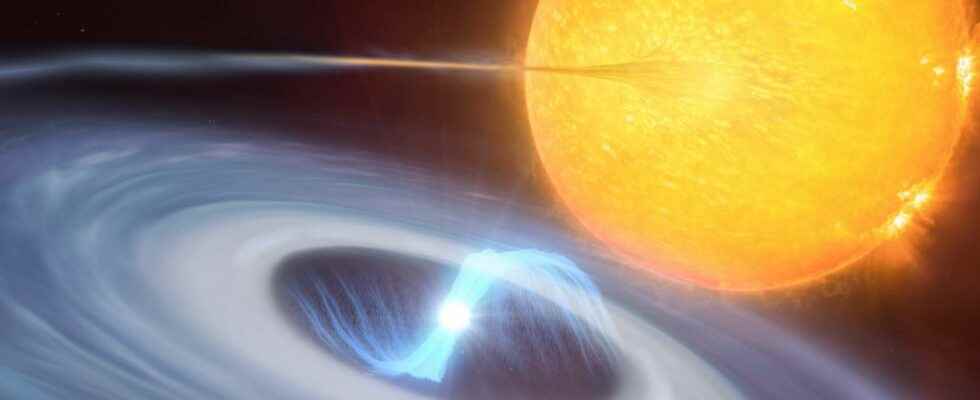As Futura has already explained, particularly in a file, it is at the end of the XVIand century that the astronomers Tycho Brahe and Johaness Kepler introduced the term nova stella, which means “new star” in Latin. Indeed, this was made necessary following the transitory appearance of new stars on the celestial vault, stars which were not mentioned by any of the stellar catalogs inherited from Greek science. But it was not until the developments of theastrophysics to the XXand century so that we begin to understand what was hidden behind these curious phenomena and that we make the distinction between novae and supernovaethanks to the work of Walter Baade and Fritz Zwicky during the 1930s. NS I and SN II of the famous classification designed by the German-American astronomer Rudolph Minkowski and Fritz Zwicky, the famous and bubbling Swiss astronomer.
But let us return to the initial dichotomy of ” novae stellae “.
Excerpt from the documentary From the Big Bang to the Living (ECP Productions, 2010). Jean-Pierre Luminet talks about the evolution of solar-type stars, their transformation into a red giant and then into a white dwarf. © Jean-Pierre Luminet
Classical novae, recurrent explosions in a binary system
We therefore know today that, unlike supernovae, novae are explosions which do not (or rarely) lead to the destruction of the parent star or which do not produce a neutron star or a black hole. In the case of a novait all starts with a white dwarf in a binary system which accreteshydrogen from its companion star until the pressure and the surface temperature become sufficient to trigger a reaction of merger explosive thermonuclear. Recall that a white dwarf is a stellar corpse which is the final fate of all stars containing less than 8 masses solar. Our Sun will end up in this state as a star hyperdense containing its mass in a volume the size of the Earth, described by quantum and relativistic effects.
When a nova occurs, the brightness of the white dwarf is then multiplied by 10,000 for a few days. The process can be repeated: we know for example that RS Ophiuchi exploded six times in a century. The novae are therefore recurrent because, as we said, the explosion does not destroy the white dwarf.
Today, the novae bestiary has just been extended following a publication in the newspaper Nature carried out by a team of astronomers who, with the help of the Very Large Telescope of the European Southern Observatory (VLT of the’ESO), observed a new type of stellar explosion that the researchers dubbed micronovae. They perform like their cousins with white dwarfs accreting from matter of a star in a binary system.
As Nathalie Degenaar, an astronomer at the University of Amsterdam in the Netherlands, explains in an ESO press release, it is thanks to the satellite Tess (Transiting Exoplanet Survey Satellite) that it all started for her and her colleagues: “ By examining the astronomical data collected by Tess de la Nasawe discovered something unusual: a flash bright from light optics that lasted a few hours. Searching further, we found several similar signals. Tess revealed three other micronovae, two of which were clearly associated with white dwarfs, but the instrument had to be used X shooter on ESO’s VLT to determine the origin of the third explosion and confirm that, again, a white dwarf was involved.
Astronomers have discovered a new type of explosion occurring on white dwarfs in two-star systems. This video summarizes the discovery. To obtain a fairly accurate French translation, click on the white rectangle at the bottom right. The English subtitles should then appear. Then click on the nut to the right of the rectangle, then on “Subtitles” and finally on “Translate automatically”. Choose “French”. © ESO
Misunderstood thermonuclear explosions
Also in the ESO press release, we learn that the researchers have determined that the thermonuclear explosion which occurs on the surface of white dwarfs, although less powerful than that of a classic nova, nevertheless converts up to ‘equivalent to the mass of 3.5 billion Great Pyramids of Giza in energy and in just a few hours. Recall that the mass of the Great Pyramid of Cheops on the Giza Plateau in Cairo is approximately 5,900,000,000 kg.
For Simone Scaringi, an astronomer at Durham University in the UK, who led the team behind the discovery of micronovae: The phenomenon challenges our understanding of how thermonuclear explosions occur in stars. We thought we knew, but this discovery offers a whole new way to do it. » Co-author of the article by Nature, Nathalie Degenaar explains that we already know, however, that in the case of micronovae: ” Such explosions cause the entire surface of the white dwarf to burn and glow for several weeks. His colleague, Paul Groot, an astronomer at Radboud University in the Netherlands, adds, however, that: For the first time, we have seen that hydrogen fusion can also occur in a localized way. Hydrogen can be contained at the base of magnetic poles of some white dwarfs, so that fusion only occurs at these magnetic poles. This leads to the explosion of micro-fusion bombs, which are about one millionth the force of a nova explosion, hence the name micronova. »
We still have many things to learn about micronovae which are probably more widespread than we think, which should allow many other observations concerning them. As Simone Scaringi finally explains: The quick response from telescopes such as the VLT or the New Technology Telescope of ESO and the suite of instruments available will allow us to discover in more detail what these mysterious micronovae are. »
Interested in what you just read?
